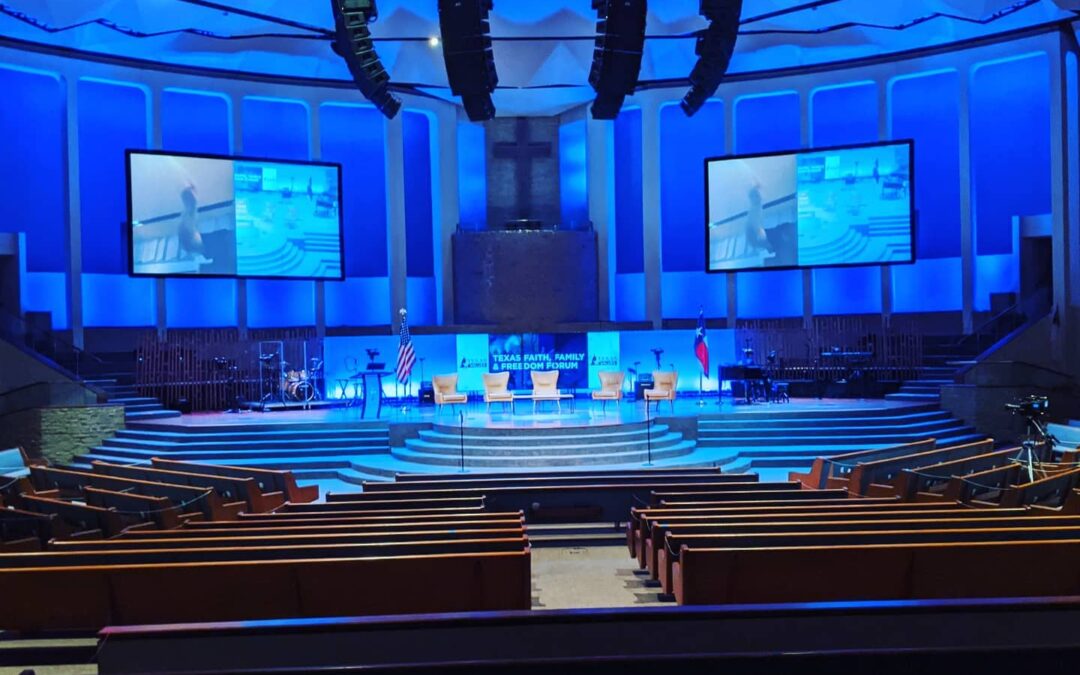In the fall, we event managed the third annual Texas Values’ Policy Forum that brought together several dozen speakers and 500+ attendees. In 2020, we planned nearly 40 events ranging from group sizes of 16-30 people gathered, some with 75-160 people, a few 200-380 person events, and then Texas Values’ conference – our largest event in 2020!
About a month prior, Texas Values hired GoodBuzz to help them plan and coordinate their annual conference. It was a joy to jump in and pull everything together. The event was two days of back-to-back speakers on specific policy topics.
We served snacks throughout the days, hosted a nice, plated dinner served Friday night as well as breakfast and lunch Saturday to attendees. We had about a dozen armed officers who patrolled the inside and outside of the multi-acre venue.
“Great job with our event! We appreciate your work in planning the 2020 Policy Forum and managing it over several days. It was our most successful event as an organization! Plus this conference gathered the most attendees we’ve ever had. Everything you did to help us succeeded our expectations. We will be contacting you to help with future projects. Thank you!” ~Jonathan Saenz, President, Texas Values
Running this event along with hosting more than 38 events in 2020 has afforded us an considerable knowledge base we’d like to share. Below are several best practices when planning an event amid a pandemic.
- Know your state and local regulations
- Sometimes these can be in opposition to one another, especially last Spring and early Summer. When in doubt, hire an attorney to give guidance to remain lawful.
- In Texas, this website guides various industries on protocols in staying open.
- Work closely with your venue host
- Communicate before, during, and after with your venue to create less miscommunication and make sure you/the client and them are on the same page in regards to adhering to regulations and going beyond to ensure a safe event.
- Open doors to have wind draft if the event is indoors
- Sit attendees further apart – like 4 or 5 people to a table that normally sits 8-10. Rope off benches so that it’s every other bench that’s available for seating.
- Establish sanitation and disinfectant protocols as well as servers/other vendors’ processes in serving your guests.
- Communicate with guests
- Require a RSVP to ensure you have adequate space for everyone who wishes to come.
- Share ahead of time with guests about your precautionary measures to ensure a safe event. Things to include are what to expect at the welcome/registration table. When are masks recommended versus not? What should they expect with seating arrangements?
- Some events we’ve managed have not publicly listed the address of the venue when marketing the event. There are many benefits to keeping the location private, but it’s paramount that you communicate with your guests in a timely fashion about where they are to show up, and ideally through several attempts to make contact by various channels to ensure they get the information.
- For some of our conference-level large events, the venues have turned off their drinking fountains or sectioned off parts of their facilities including limiting the number of restrooms available. In these cases, it is important to properly prepare guests to bring their own water or help the client purchase thousands of bottled waters to have onsite. Inform guests that signage will prepare them for areas of the facility that are closed.
- As always, close an event with a post-event thank you email that wraps up the event and highlights information (lost and found, ways to give, products to buy, next event, ect.)
- Stock adequate supplies
- Have hand sanitizer and masks at the entrance and throughout the event venue.
- Encourage attendees to wear/bring their own supplies, or to utilize your sanitation station upon entry.
- Taping signs on the ground to maintain social distancing can be helpful for large events where folks are gathering or queuing up to take a photo, go through a buffet line, or purchase items.
- 5. Properly train workers & volunteers
- Supply event employees/volunteers with faceshields or gloves if working an entrance or in a high-volume area
- Train them on appropriate cleaning and disinfection etiquette, especially in high-trafficked locations like bathrooms and entrances/exits
- 6. Protect yourself legally
- Ask guests to sign waivers upon entrance. Several larger events I’ve managed we had attorneys draft the document that had guests initial various statements about not being exposed to others with covid and not having a high temperature with their signature admitting they wouldn’t blame the venue nor the client should they contract any diseases and that attending the event and any consequences from it was their full responsibility.
- Take attendees’ temperatures upon entrance (I’m personally opposed to this, but some clients prefer this.)
In all these events, I have not received one mention of anyone getting the Chinese virus. With thoughtful planning and proper precautions, brands, colleagues, and friends were able to resume meeting together. Many attendees shared how grateful they were to assemble with others again – and that the experience encouraged their spirit and improved their mental health.
Please consider GoodBuzz for your next event; we work to ensure safe and memorable events for our great clients! We also can help your brand get a good buzz by doing PR, digital marketing, website blogs, and social media. Contact us today!
